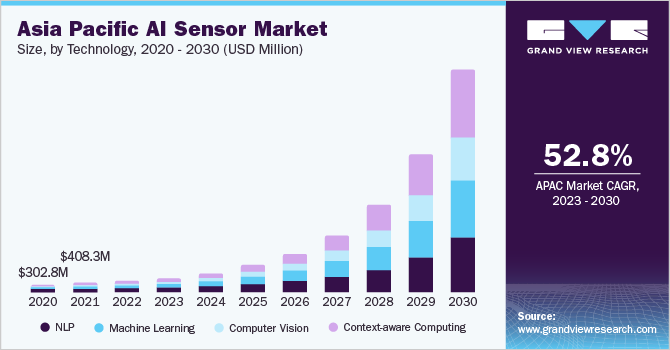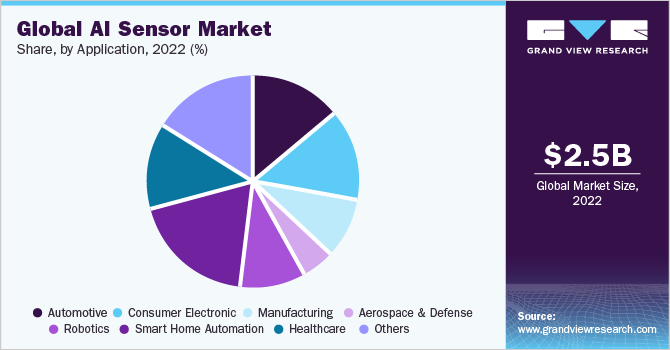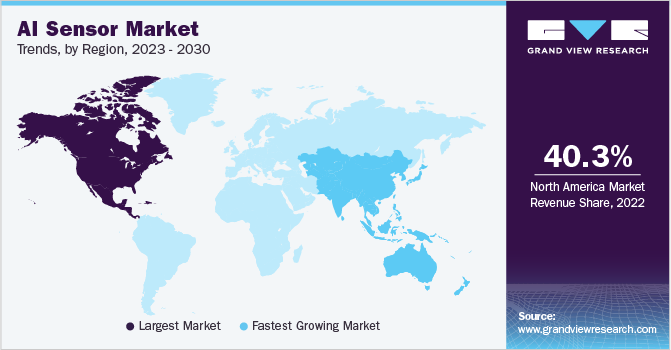- Home
- »
- Next Generation Technologies
- »
-
Artificial Intelligence (AI) Sensor Market Size Report, 2030GVR Report cover
![Artificial Intelligence (AI) Sensor Market Size, Share & Trends Report]()
Artificial Intelligence (AI) Sensor Market Size, Share & Trends Analysis Report By Technology (NLP, Machine Learning, Computer Vision, Context-aware Computing), By Sensor Type, By Application, By Region, And Segment Forecasts, 2023 - 2030
- Report ID: GVR-4-68040-087-4
- Number of Pages: 100
- Format: Electronic (PDF)
- Historical Range: 2017 - 2021
- Industry: Technology
AI Sensor Market Size & Trends
The global artificial intelligence (AI) sensor market size was valued at USD 2.5 billion in 2022 and is expected to grow at a compound annual growth rate (CAGR) of 43.6% from 2023 to 2030. The rising demand for life-saving healthcare equipment and self-driving capabilities in new electric vehicles are the factors anticipated to drive the growth. The shift in focus on digitization worldwide is anticipated to further fuel the growth. Major technology companies, like Apple Inc.; Google LLC; Microsoft Corporation; and IBM Corporation are increasing their investments in developing various AI applications. Increasing initiatives by tech companies to expand access to artificial intelligence (AI) will boost market growth throughout the forecast period.

The growing proliferation of IoT devices and connected systems fuels the demand for AI sensors. AI sensors are crucial in collecting and analyzing data from IoT devices, enabling intelligent decision-making, automation, and predictive analytics. Moreover, continuous advancements in AI algorithms, machine learning, and sensor technologies are key growth drivers for the artificial intelligence sensor market. These advancements contribute to the development of more capable and efficient AI sensors, enabling a wide range of applications across industries.
The healthcare sector is a significant market growth driver. AI sensors are used for remote patient monitoring, early disease detection, personalized medicine, and healthcare robotics. For example, AI sensors integrated with imaging devices can assist in detecting cancer, tumors, and other abnormalities, leading to earlier interventions and improved patient outcomes. Furthermore, the popularity of wearable health devices equipped with AI sensors has grown significantly. These devices, such as fitness trackers, smartwatches, and wearable ECG monitors, provide real-time health data to individuals, promoting self-monitoring and proactive health management.
Government policies, funding initiatives, and collaborations are crucial in shaping the growth and adoption of AI sensors worldwide. For example, The European Union has allocated significant funding for AI-related initiatives, including AI sensors. For instance, the Horizon 2020 program, the EU's largest research and innovation program, has dedicated Euro 1.5 billion to projects related to AI technologies. Additionally, the European Commission has launched the Digital Europe Program, which aims to invest in key digital technologies, including artificial intelligence, supercomputing, advanced digital skills, and cybersecurity.
Technology Insights
The machine learning segment dominates the market with a revenue share of 31.5% in 2022. This growth is attributed to the enormous availability of data, also called big data. By analyzing large amounts of sensor-generated data, machine learning algorithms can identify correlations, anomalies, and trends that might not be apparent through traditional programming methods. This capability enables more accurate and intelligent decision-making based on sensor inputs. Integrating machine learning with sensors empowers AI systems to learn and adapt over time, improving their performance and capabilities. By leveraging machine learning, AI sensors can become more sophisticated in their ability to understand and interpret sensor data, leading to enhanced automation, intelligent monitoring, and predictive analysis.
The context-aware computing segment is expected to grow at the fastest CAGR during the forecast period. The growth of the context-aware computing segment can be attributed to advancements in sensor technologies that have led to the development of more sophisticated and accurate sensors capable of capturing detailed environmental data. These sensors can collect information such as location, temperature, motion, light, and sound, which is crucial for context-aware computing systems. Furthermore, its ability to leverage sensor data, IoT connectivity, and AI techniques to deliver personalized and adaptive experiences makes it a highly sought-after technology in today's digital landscape.
Sensor Type Insights
The optical sensor segment dominates the market with a revenue share of 20.0% in 2022. The growing demand for visual data processing and analysis primarily drives the growth. With the increasing adoption of AI technologies and the proliferation of applications relying on computer vision, optical sensors have become essential in capturing and interpreting visual information. Moreover, optical sensors have been widely adopted in various industries and applications, including autonomous vehicles, robotics, industrial automation, healthcare, and consumer electronics.
The ultrasonic sensor segment is expected to grow at the fastest CAGR of 46.2% from 2023 to 2030. The increasing adoption of automation, robotics, and autonomous systems in manufacturing, logistics, and automotive industries is expected to drive the demand for ultrasonic sensors. These sensors play a vital role in obstacle detection, collision avoidance, and proximity sensing, enabling safer and more efficient operations. Moreover, ultrasonic sensors are emerging applications in areas such as healthcare, smart cities, and agricultural automation. For example, in healthcare, ultrasonic sensors can be utilized for non-invasive monitoring, gesture control, and imaging applications.
Application Insights
The smart home automation segment dominates the market with a revenue share of 19.1% in 2022. The factor attributed to the segment’s growth is the growing demand for home automation solutions as homeowners seek to enhance convenience, energy efficiency, security, and overall comfort within their homes. The smart home automation application refers to using artificial intelligence (AI) sensors in various devices and systems within a smart home environment. AI sensors are advanced sensors that incorporate AI capabilities to enhance automation, data processing, and decision-making within smart home systems.

The robotics segment is expected to grow at a CAGR of 47.1% from 2023 to 2030. Artificial intelligence sensors are becoming more advanced, capable, and affordable. These sensors enable robots to perceive and interpret their surroundings, allowing them to navigate autonomously, avoid obstacles, and interact with objects and humans more effectively. As AI sensor technology continues to evolve, robots are expected to become smarter and more capable, leading to increased adoption in various industries.
Regional Insights
North America dominates the market with a revenue share of 40.3% in 2022. North America has been a prominent region due to its strong technological infrastructure, presence of key players, and significant investments in research and development. The United States has been a major contributor to the market growth, driven by the presence of tech giants and a thriving startup ecosystem focusing on AI and sensor technologies. The region has also focused on regulations and initiatives to promote ethical AI and data privacy, influencing the adoption and development of AI sensor technologies.

Asia Pacific is expected to grow at the fastest CAGR of 52.8% from 2023 to 2030. The Asia Pacific region has witnessed rapid growth of the market. Countries such as China, Japan, South Korea, and India have been at the forefront of adopting AI technologies and integrating them into various industries. The region's manufacturing capabilities, increasing industrial automation, and growing demand for consumer electronics have contributed to the market's expansion. Moreover, the market continues to evolve, and new regional trends may emerge based on factors such as policy changes, market dynamics, and technological advancements.
Key Companies & Market Share Insights
The market is characterized by strong competition, with a few major worldwide competitors owning a significant market share. The major focus is on developing new products and collaboration among the key players. Some prominent players in the global artificial intelligence (AI) sensor market include:
-
ACI Worldwide
-
Baidu, Inc.
-
BAE Systems
-
LexisNexis Risk Solutions
-
Oracle Corporation
-
Robert Bosch GmbH
-
Sensata Technologies, Inc.
-
Sensirion AG
-
Silicon Sensing Systems Limited
-
Sony Corporation
-
SAS Institute
-
Teledyne Technologies Incorporated
Artificial Intelligence (AI) Sensor Market Report Scope
Report Attribute
Details
Market size value in 2023
USD 3.26 billion
Revenue forecast in 2030
USD 41.17 billion
Growth rate
CAGR of 43.6% from 2023 to 2030
Base year for estimation
2022
Historical data
2017 - 2021
Forecast period
2023 - 2030
Quantitative units
Revenue in USD million & CAGR from 2023 to 2030
Report coverage
Revenue forecast, company ranking, competitive landscape, growth factors, and trends
Segments covered
Technology, sensor type, application, region
Regional scope
North America; Europe; Asia Pacific; Latin America; Middle East & Africa
Country scope
U.S.; Canada; UK; Germany; France; China; Japan; India; South Korea; Australia; Brazil; Mexico; Kingdom of Saudi Arabia (KSA); UAE; South Africa
Key companies profiled
ACI Worldwide; Baidu, Inc.; BAE Systems; LexisNexis Risk Solutions; Oracle Corporation; Robert Bosch GmbH; Sensata Technologies, Inc.; Sensirion AG; Silicon Sensing Systems Limited; Sony Corporation; SAS Institute; Teledyne Technologies Incorporated
Customization scope
Free report customization (equivalent up to 8 analysts working days) with purchase. Addition or alteration to country, regional, and segment scope.
Global Artificial Intelligence (AI) Sensor Market Report Segmentation
This report forecasts revenue growth on global, regional, and country levels and provides an analysis of the latest industry trends in each of the sub-segments from 2017 to 2030. For this study, Grand View Research has segmented the global artificial intelligence (AI) sensor market report based on technology, sensor type, application, and region:
-
Technology Outlook (Revenue, USD Million, 2017 - 2030)
-
NLP
-
Machine Learning
-
Computer Vision
-
Context-aware Computing
-
-
Sensor Type Outlook (Revenue, USD Million, 2017 - 2030)
-
Pressure
-
Temperature
-
Optical
-
Position
-
Ultrasonic
-
Motion
-
Navigation
-
Others
-
-
Application Outlook (Revenue, USD Million, 2017 - 2030)
-
Automotive
-
Consumer Electronic
-
Manufacturing
-
Aerospace & Defense
-
Robotics
-
Smart Home Automation
-
Healthcare
-
Others
-
-
Regional Outlook (Revenue, USD Million, 2017 - 2030)
-
North America
-
U.S.
-
Canada
-
-
Europe
-
U.K.
-
Germany
-
France
-
-
Asia Pacific
-
China
-
Japan
-
India
-
South Korea
-
Australia
-
-
Latin America
-
Brazil
-
Mexico
-
-
Middle East and Africa
-
Kingdom of Saudi Arabia (KSA)
-
UAE
-
South Africa
-
-
Frequently Asked Questions About This Report
b. The global artificial intelligence (AI) sensor market size was estimated at USD 2.5 billion in 2022 and is expected to reach USD 3.26 billion in 2023
b. The global artificial intelligence sensor market is expected to grow at a compound annual growth rate of 46.3% from 2023 to 2030 to reach USD 41.17 billion by 2030.
b. North America dominated the artificial intelligence sensor market with a share of 40.3% in 2022. This is attributable to rising healthcare awareness coupled with cloud-based technologies acceptance and constant research and development initiatives.
b. Some key players operating in the AI sensor market include ACI Worldwide, Baidu, Inc., BAE Systems, LexisNexis Risk Solutions, Oracle Corporation, Robert Bosch GmbH, Sensata Technologies, Inc., Sensirion AG, Silicon Sensing Systems Limited, Sony Corporation, SAS Institute, Teledyne Technologies Incorporated.
b. Key factors that are driving the artificial intelligence (AI) sensor Market growth include rising demand for life-saving healthcare equipment and self-driving capabilities in new electric vehicles.
Share this report with your colleague or friend.
![gvr icn]()
NEED A CUSTOM REPORT?
We can customize every report - free of charge - including purchasing stand-alone sections or country-level reports, as well as offer affordable discounts for start-ups & universities. Contact us now
![Certified Icon]()
We are GDPR and CCPA compliant! Your transaction & personal information is safe and secure. For more details, please read our privacy policy.
We are committed towards customer satisfaction, and quality service.
"The quality of research they have done for us has been excellent."





